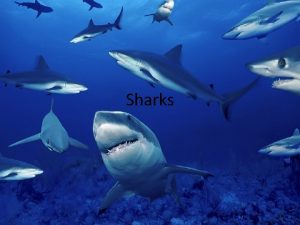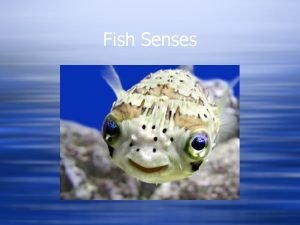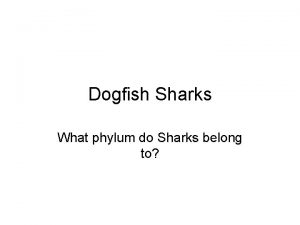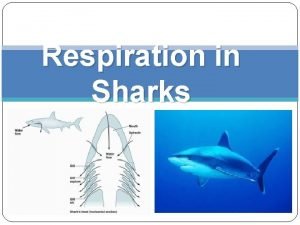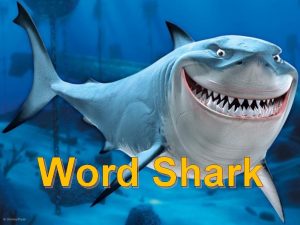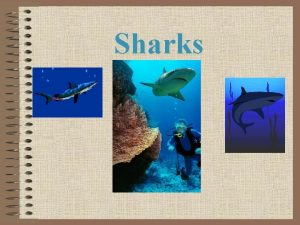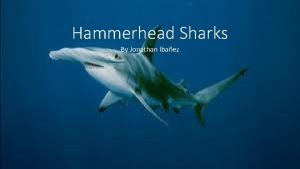I Sharks II Evals Finally Sharks A shark





























- Slides: 29

I. Sharks II. Evals

Finally! Sharks A shark is a fish – what is a fish?

Three types of ‘fin’ fish or ‘true fish’: • Jawless fish: ~ 100 species. Primitive. Lack a jaw, cylindrical and elongated bodies, no scales or paired fins. Few commercial uses. e. g. Eels or snakes • Cartilaginous fish: ~900 species. Cartilaginous skeletal structure, moveable jaws, teeth, lateral fins, and tiny scales (like sandpaper). Large livers hold a lots of oil - helps to prevent sinking. E. g. , Sharks, Rays, Skates. • Bony fish: >27, 000 species. ~96% of all known fishes, nearly half of all vertebrates. Skeletons composed of bone. Thin, flexible overlapping scales, fins composed of bony spines rather than flesh, and a swim bladder (rather than liver) for buoyancy.

Chondrichthyan – class of fish that include sharks • Chondrichthyan include sharks, rays, skates, chimaeras (ghost fish) • Type of cartilaginous fish • Vertebrate (skeleton made of cartilage, not bone)

Shark Anatomy • Have a lot of cartilage – flexible, durable, half the normal density of bone, so sharks are light (can swim easier) • Most have 8 fins (5 different types of fins).

Shark skin is crazy: “placid scales” or “dermal denticles” • Bony, spiny projections with enamel-like covering • Similar to teeth – referred to as “dermal denticles” (dermal=skin, denticle=teeth) • Slanted toward tail – helps direct flow of water around the shark's body, reducing friction • Smooth to touch when stroke from head to tail • Stroke tail to head – ouch! Used as sandpaper in some countries and used to hurt prey • Shape varies among species https: //micro. magnet. fsu. edu/optics/olympusmicd/galleries/darkfield/dogfishplacoidscale. html

Mathematics of Shark skin:

Shark biology continued • Large liver: 30% body weight, filled w/ oil – used for buoyancy • Cartilage also helps with buoyancy • Most cold blooded – but few species can raise internal temperature • Relatively slow digestive track – (shorter intenseness than mammals) Great White Shark

• Varying lifespans, but most live 20 -30 years • Longest lived vertebrate ever might be a shark (Greenland shark), which >200 yrs, maybe even 300 yrs old! • Some (e. g. spiny dogfish, whale sharks) >100 years • Swim ~8 km/hr normally, but can reach ~20 km/hr when attacked or attacking. • Mako shark is fastest shark – max speed >50 km/hr Mako shark

Sharks are old • ~420 million yrs old (but looked different from modern sharks) • Modern sharks evolved ~100 million yrs ago • How do we know this? Teeth as fossils! Multiple rows of replacement teeth – each tooth replaced one at a time Grow in groove on the inside of the jaw Lose >30, 000 teeth in lifetime Rate of tooth replacement: wk to months

Sharks have fewer babies compared to bony fish – and they grow and mature more slowly. Young are more developed than bony fish Like most fish – all sharks do internal fertilization Males have ‘claspers’, which provides sperm to female (close to pelvic fins) Males often bite females during mating to basically ‘hold on’ to her Some sharks lay eggs (~40%), most do not (~60%)! Egg laying sharks = “oviparous” Live-bearing = “viviparous” No parental care

Sharks as predators A few well known sharks are apex predators = no natural predators. Top of food chain. But many shark species are relatively small and are prey to other fish Are apex predators also keystone species? Many are, but some not. E. g. , sea otters are keystone species, but killer whales eat sea otters, so killer whale are apex predator in that food web.

Why sharks are successful predators • Amazing sense of smell • Can smell tiny amts of blood in water - determine where smell is coming from based on timing of detection in nostrils • Great eye sight – some color blind, some have night vision • Lateral line (all fish have this) Series of tubes located just below the surface of the skin Run lengthwise, both sides from head to tail Water flows into the tubes through pores in skin Tubes lined with hair-like projections connected to sensory cells Sensory cells stimulated by sound, vibration, and pressure changes. Alerts shark to potential prey https: //www. floridamuseum. ufl. edu/fish/discover/sharks/biology

Why sharks are successful predators (continued) ampullae of Lorenzini receptors that detect weak electric fields Unique to sharks Visible Works because all animals emit weak electric fields due to muscle movement – sharks can detect this • Used to locate hidden prey that can’t be seen, heard, or smelled • • • (i. e. stingrays buried in sand) https: //www. youtube. com/watch? v=MB 2 u. COMx_t 0 https: //www. floridamuseum. ufl. edu/fish/discover/sharks/biology/

Shark Electrosensory system

Types and species of sharks The biggest fish in the world is a shark! Which one? • Over 400 species of sharks • Range in size: dwarf lantern shark (17 cm) to the whale shark (12 m, largest fish in the world) dwarf lantern shark • Sharks are all over: • • In every ocean Polar to tropical water Coastal and open ocean Shallow vs deep • Mostly found in marine waters In class activity time!

Popular shark species • Great white shark • Whale shark • Tiger shark • Bamboo shark • Cookiecutter shark • Mako shark Skip to 1 min 22 sec: https: //www. youtube. com/watch? v=Iyq 4 U 1 k 5 r. Rc

Whale sharks are different than many other sharks • • slow-moving filter-feeding the largest known extant fish species. The largest confirmed individual had a length of 12. 65 m and a weight of about 21. 5 t


We stopped here – but the remaining slides might be of interest to you. Any material after this slide will not be on the final exam.

Whale Sharks Skip to 2: 30

How dangerous are sharks to humans? • ~5 -15 pple die each yr globally from shark attacks • Three species responsible for majority of attacks on humans (Great white, Tiger, Bull) • Chances are worse than 1 in 3 million of getting killed by a shark • You’re more likely to DIE via: • • • Fireworks Struck by lightning Drowning Car accident Heart disease On the other hand, humans kill ~8, 000 sharks per hour (26 -73 million sharks per yr)

Shark populations are not doing very well • A quarter (25%) of all chondrichthyan (sharks, rays, chimaeras) are threatened • Why? • High habitat specificity, small geographic ranges, pollution • Degradation of coastal ecosystems • Shark finning – cut off fin and throw rest of animal back to suffer • Huge market value • Fins worth ~$400 -500/lb • Slow reproduction rate (some of longestation times: 2 -3 yrs), slow to sexually mature

Shark populations are not doing very well 45% of species – data deficient!

Threats: targeted, incidental catches, habitat loss Rays more threatened than sharks

# of species, by habitat type 150 species regularly migrate across international boundaries – ¼ of threatened species have a range that includes 18 countries

What happens to ecological community when sharks disappear? • Smooth hammerheads eat rays. • If hammerheads go away, ray populations increase • Rays eat more bivalves…then no more oysters, scallops, etc. Eventually ray populations suffer.

Value of sharks: tourism vs. food • Shark-watching tourism generates $314 million/yr • Value of tourism increasing - projected at $780/yr million in the next 20 yr • Landed value of world shark fisheries $630 million/yr • But this value is in decline http: //www. reuters. com/article/us-sharks/sharks-worth-more-for-tourism-than-in-soup-study-id. USBRE 94 T 17020130531

Who would win a fight? A spiny dogfish shark or a giant pacific octopus? ! Lets see (skip to 1: 30): https: //www. youtube. com/watch? v=p 9 A-ox. UMAy 8
 Nau course evals
Nau course evals Do hammerhead sharks attack people
Do hammerhead sharks attack people Closing of the western frontier
Closing of the western frontier Macbeth study guide act 4
Macbeth study guide act 4 Paraphrase in a sentence
Paraphrase in a sentence When does grendel finally show fear
When does grendel finally show fear Estabraq muayad
Estabraq muayad Finally my brethren
Finally my brethren Questions for the tell tale heart
Questions for the tell tale heart Finally brothers whatever is true
Finally brothers whatever is true Suffixes for friend
Suffixes for friend In his darkroom he is finally alone war photographer
In his darkroom he is finally alone war photographer I had finally gotten used to being weightless
I had finally gotten used to being weightless Did you ever have to finally decide
Did you ever have to finally decide In what century were negative numbers finally accepted
In what century were negative numbers finally accepted Finally my brother be strong in the lord
Finally my brother be strong in the lord She got the job because she
She got the job because she Bridge to terabithia chapter questions
Bridge to terabithia chapter questions Finally brethren farewell
Finally brethren farewell We finally arrived at your destination
We finally arrived at your destination What revelation does the messenger make to oedipus?
What revelation does the messenger make to oedipus? Sharks use magnetic field to navigate
Sharks use magnetic field to navigate Flickr
Flickr Sharks
Sharks What kingdom are sharks in
What kingdom are sharks in Sharks
Sharks Sharks body shape
Sharks body shape Vision in fishes
Vision in fishes Meredith sanders
Meredith sanders Dogfish
Dogfish
























